
#AcWri Thread:
My students ALWAYS ask me the question:
"How do I go from having the Detailed Outline to actually writing a Memorandum (or a series of Memos) that I can then assemble into the full draft of the paper?"
Well, everyone: Grab a chair because HERE IT GOES.
My students ALWAYS ask me the question:
"How do I go from having the Detailed Outline to actually writing a Memorandum (or a series of Memos) that I can then assemble into the full draft of the paper?"
Well, everyone: Grab a chair because HERE IT GOES.
As you all know I’m finishing a chapter on ethnography in comparative environmental politics.
Comparative is what I do and who I am.
This doesn’t mean that it’s any easier to write. So I always go back to basics.
1) Initial Outline. Basic layout of ideas, headings/thoughts.
Comparative is what I do and who I am.
This doesn’t mean that it’s any easier to write. So I always go back to basics.
1) Initial Outline. Basic layout of ideas, headings/thoughts.
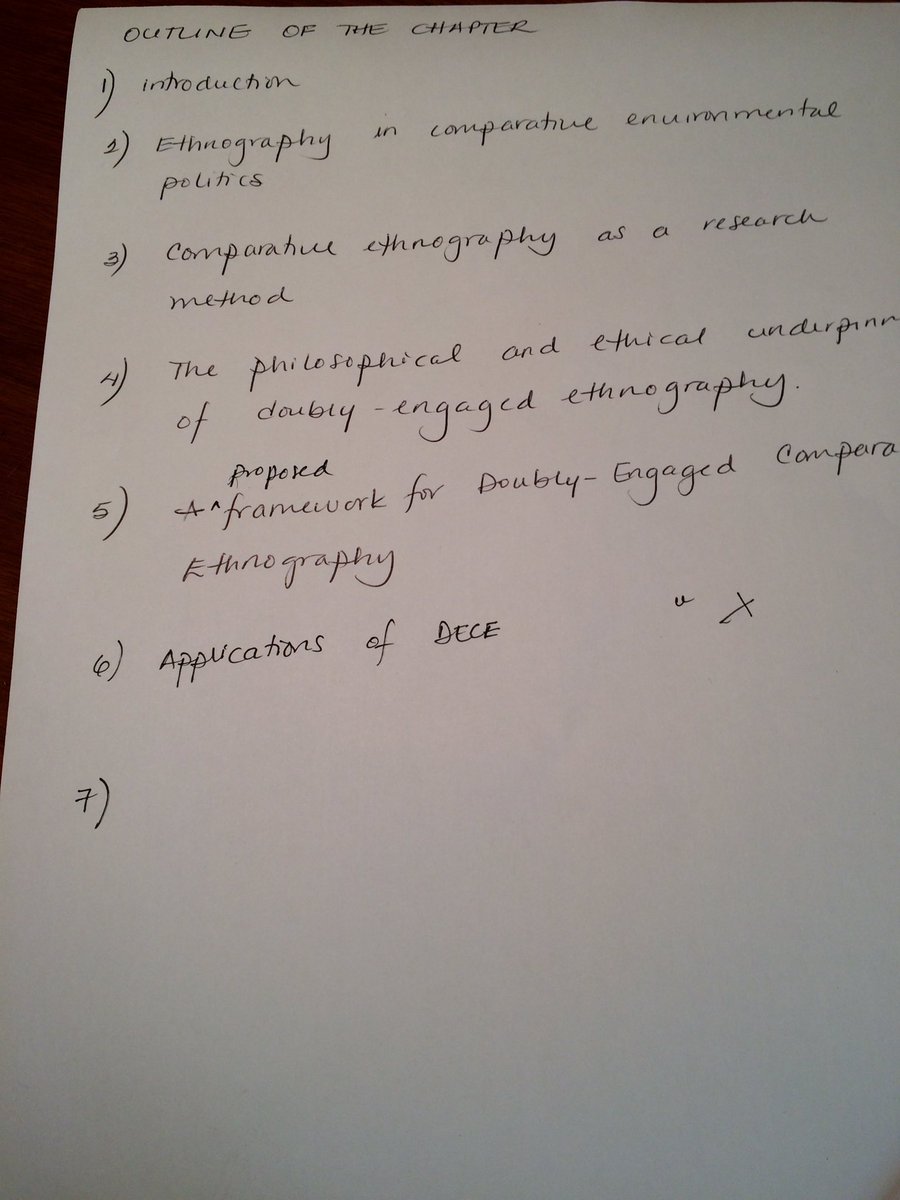
2) Break down each chapter heading/main idea into ideas/Topic Sentences/Triggering Questions.
As you can see here, I grabbed the “ethnography in CEP” and started writing Triggering Questions that help trigger my thinking.
I start adding more detail to the heading outline.
As you can see here, I grabbed the “ethnography in CEP” and started writing Triggering Questions that help trigger my thinking.
I start adding more detail to the heading outline.
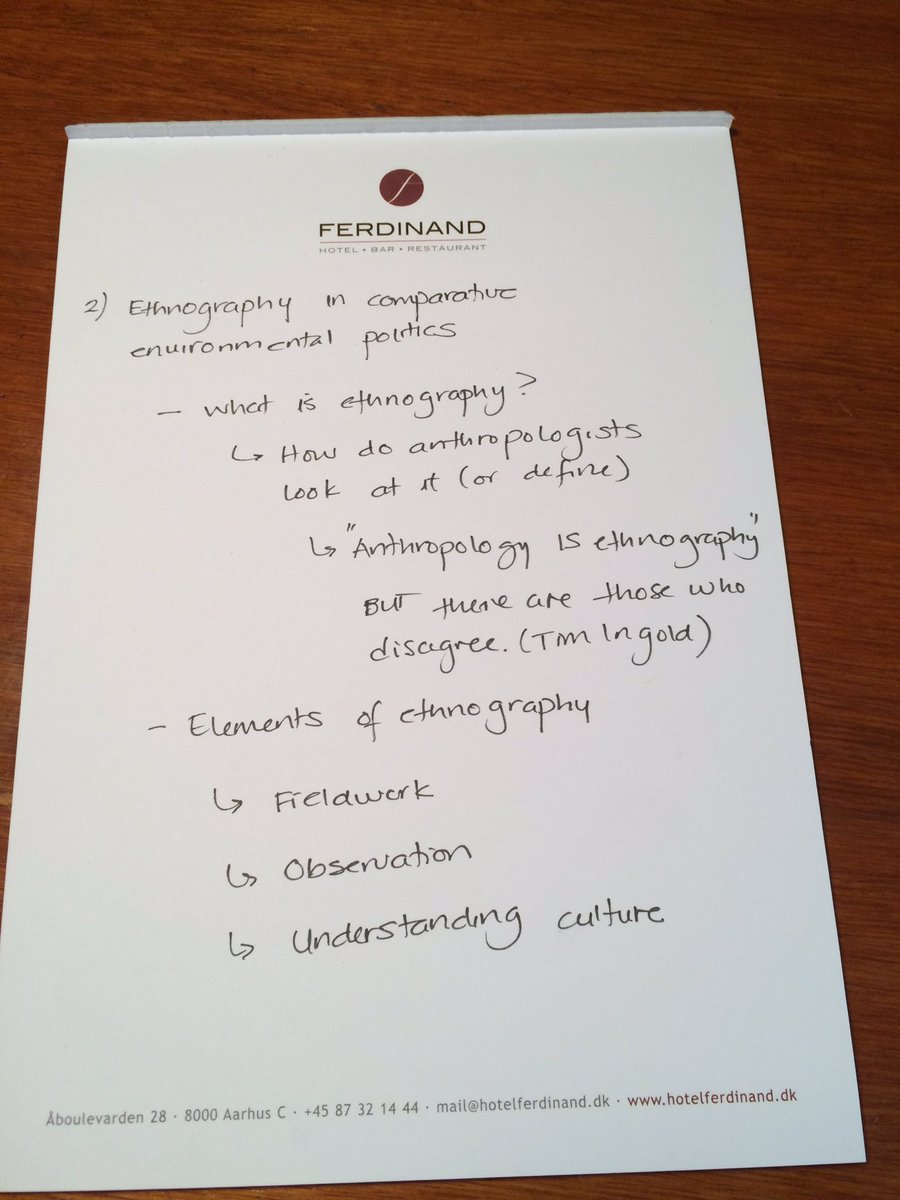
This is the initial draft of my Initial Outline.
As you can see, there are still a number of major headlines that need to be detailed.
It's tempting to just go ahead with writing the first few elements of the Detailed Outline (I am IMPATIENT as hell).
DO NOT DO THIS.
As you can see, there are still a number of major headlines that need to be detailed.
It's tempting to just go ahead with writing the first few elements of the Detailed Outline (I am IMPATIENT as hell).
DO NOT DO THIS.
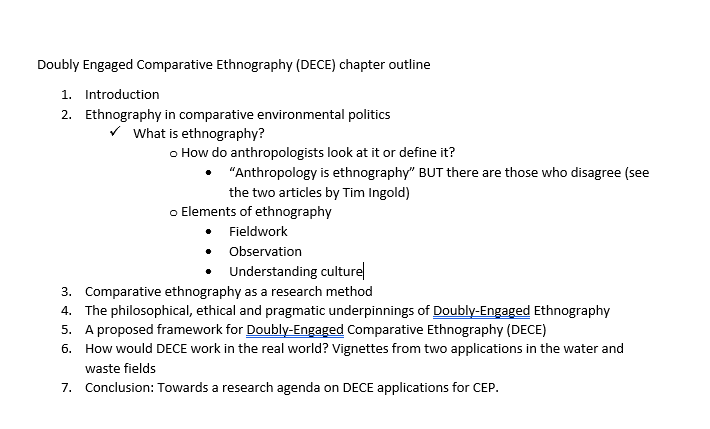
My first advice to students when writing outlines is ALWAYS FINISH THE INITIAL OUTLINE FIRST.
My second piece of advice: is: FINISH DRAFTING THE DETAILED OUTLINE FIRST.
Reason for finishing the Detailed Outline first? You will be able to see the overall argument, "bird's eye"
My second piece of advice: is: FINISH DRAFTING THE DETAILED OUTLINE FIRST.
Reason for finishing the Detailed Outline first? You will be able to see the overall argument, "bird's eye"
Here is my post on Initial Outlines and Detailed Outlines.
raulpacheco.org/2020/11/writin…
Here is my post on Writing by Memorandums.
raulpacheco.org/2020/04/writin…
Here is my post on how I develop outlines using Topic Sentences and Triggering Questions
raulpacheco.org/2018/03/two-me…
raulpacheco.org/2020/11/writin…
Here is my post on Writing by Memorandums.
raulpacheco.org/2020/04/writin…
Here is my post on how I develop outlines using Topic Sentences and Triggering Questions
raulpacheco.org/2018/03/two-me…
Now, another key question that my students ask me regularly:
"Professor, how do you decide what goes into your memorandum?"
Generally speaking, I try to write ONE memorandum per Triggering Question.
For example, in this case: "what is ethnography?" would be ideal for a memo.
"Professor, how do you decide what goes into your memorandum?"
Generally speaking, I try to write ONE memorandum per Triggering Question.
For example, in this case: "what is ethnography?" would be ideal for a memo.
Now, for the "breaking down the big project into small pieces" part of this thread:
Different people use different strategies for outlining.
I teach most of them.
One of them is outlining by hand (as I have been doing)
Others outline directly on screen.
Yet others use...
Different people use different strategies for outlining.
I teach most of them.
One of them is outlining by hand (as I have been doing)
Others outline directly on screen.
Yet others use...
... Mind Maps.
raulpacheco.org/2016/12/mind-m…
(I've written other posts on mind mapping for literature reviews, see below:)
- raulpacheco.org/2019/08/on-rea…
- raulpacheco.org/2019/08/from-r…
- raulpacheco.org/2019/07/a-prop…
(for this particular mind map, I used mindmaps.app/#)
raulpacheco.org/2016/12/mind-m…
(I've written other posts on mind mapping for literature reviews, see below:)
- raulpacheco.org/2019/08/on-rea…
- raulpacheco.org/2019/08/from-r…
- raulpacheco.org/2019/07/a-prop…
(for this particular mind map, I used mindmaps.app/#)
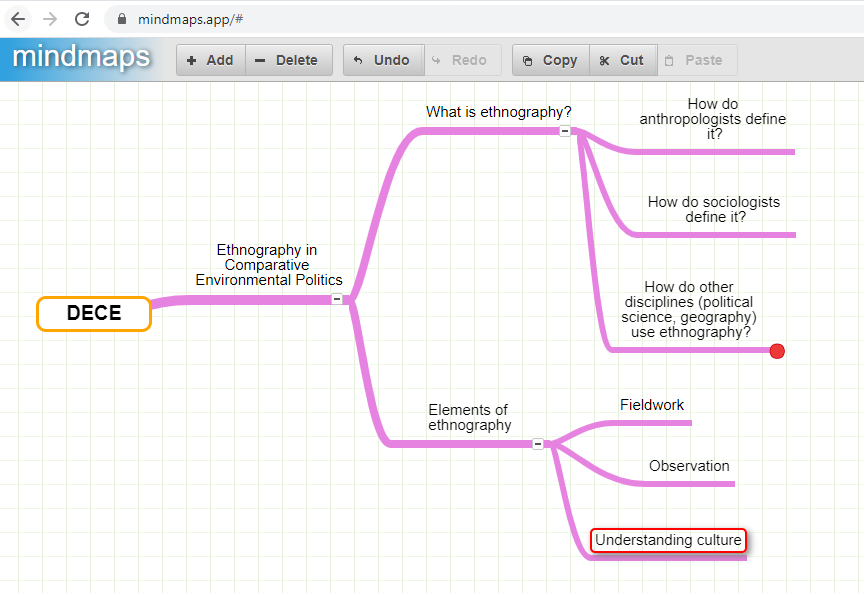
Personally, I'm not tied to any model for outlining (directly in Scrivener, Word, or whichever word processor you use, by hand, or using mind maps).
I find that combining these techniques (digital and analog) really helps me refine and hone the final product.
I find that combining these techniques (digital and analog) really helps me refine and hone the final product.
Now, let's move from the Detailed Outline to the Writing Memorandums stage.
Here's what I do:
1) I break down the Topic Sentence or Triggering Question into its elements.
2) I begin a memorandum using heading-level Triggering Questions or Topic Sentences
Here's what I do:
1) I break down the Topic Sentence or Triggering Question into its elements.
2) I begin a memorandum using heading-level Triggering Questions or Topic Sentences
Let's grab the "What is Ethnography" Triggering Question, and the "Elements of Ethnography" Topic Sentence/Sub-Heading.
In my mind, there are three key elements to ethnography:
- Observation
- Fieldwork
- Understanding culture.
I can use those to start my Memorandum.
In my mind, there are three key elements to ethnography:
- Observation
- Fieldwork
- Understanding culture.
I can use those to start my Memorandum.
I have a blog post on how you can write effective memorandums.
raulpacheco.org/2016/07/writin…
A quick search through my Mendeley library for "what is ethnography" yields a lot of great suggestions.
raulpacheco.org/2016/07/writin…
A quick search through my Mendeley library for "what is ethnography" yields a lot of great suggestions.

This is the moment when we need to READ AGAIN to make the argument and start writing the Memorandum.
My students think that we read, read, read, read, and THEN WHAM BAM, there's a paper.
No, writing requires us to think, mull over, reflect and write in smaller chunks.
My students think that we read, read, read, read, and THEN WHAM BAM, there's a paper.
No, writing requires us to think, mull over, reflect and write in smaller chunks.
"How do I even begin to write a Memorandum?"
I usually start drafting ideas on paper, be it on a notepad, or a series of index cards.
Those of you who read my blog and follow me may wonder "why not draft in your Everything Notebook"
HELL NO.
My Everything Notebook is for...
I usually start drafting ideas on paper, be it on a notepad, or a series of index cards.
Those of you who read my blog and follow me may wonder "why not draft in your Everything Notebook"
HELL NO.
My Everything Notebook is for...
... "cleaner writing".
In my Everything Notebook I only take "clean notes". Neat handwriting, many colours.
raulpacheco.org/resources/the-…
I have Draft Notebooks/Notepads that I use to jot down sketches of papers/memoranda.
I also use index cards to draft thoughts, ideas.
In my Everything Notebook I only take "clean notes". Neat handwriting, many colours.
raulpacheco.org/resources/the-…
I have Draft Notebooks/Notepads that I use to jot down sketches of papers/memoranda.
I also use index cards to draft thoughts, ideas.
After a nap, here's what the finalized Detailed Outline looks like.
I tell my students that my outlines (both Initial and Detailed) are fluid. Too much rigidity makes writing harder.
I will be ok if my thinking takes me other places.

I tell my students that my outlines (both Initial and Detailed) are fluid. Too much rigidity makes writing harder.
I will be ok if my thinking takes me other places.
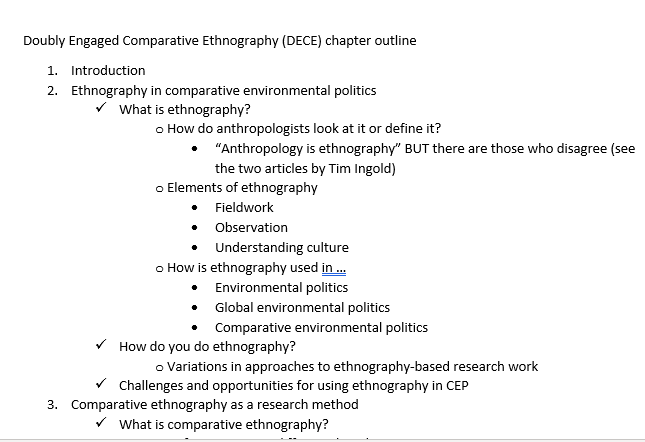

On the left you will find what one of my index cards on the first Triggering Question looks like.
On the right you will find the beginnings of my Memorandum on the Triggering Question “what is ethnography” - they’re a tiny bit different but that’s ok.
From here on...

On the right you will find the beginnings of my Memorandum on the Triggering Question “what is ethnography” - they’re a tiny bit different but that’s ok.
From here on...
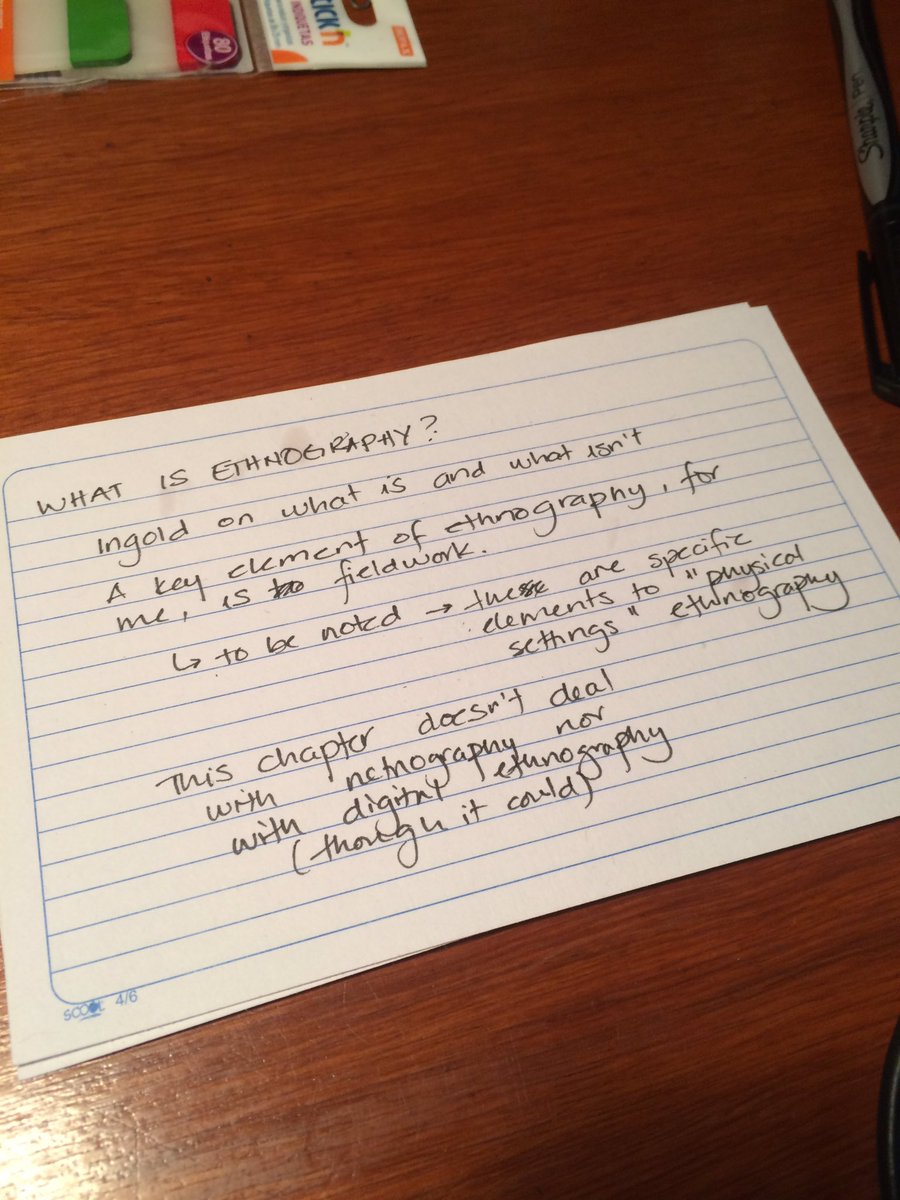
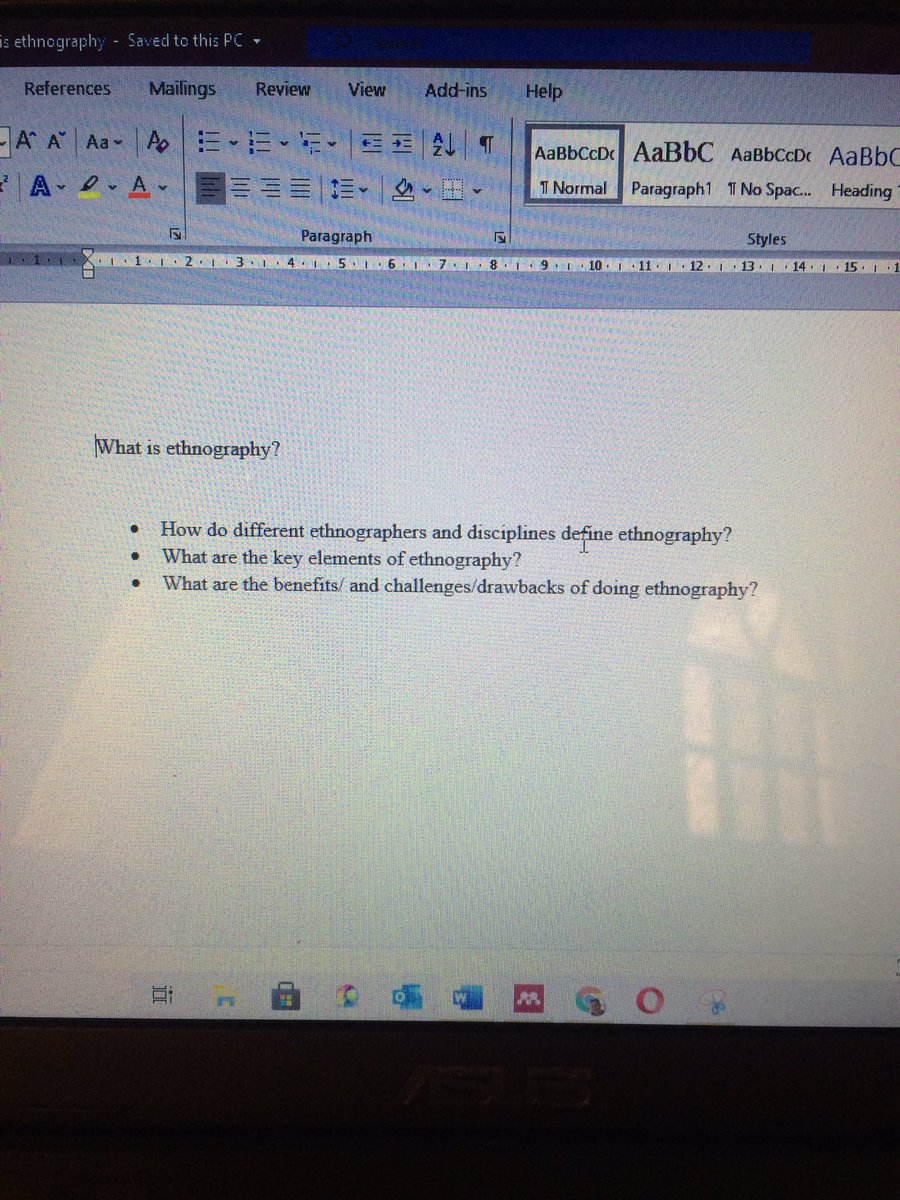
Now we can start writing up topic sentences and filling up paragraphs in each memorandum. Here are three blog posts on how to do this. Adapt as you see fit for your workflow.
- raulpacheco.org/2018/10/writin…
- raulpacheco.org/2019/08/on-rea…
- raulpacheco.org/2020/08/a-few-…
- raulpacheco.org/2018/10/writin…
- raulpacheco.org/2019/08/on-rea…
- raulpacheco.org/2020/08/a-few-…
You can follow and adapt this process for each component of a paper, book chapter, book, thesis chapter or entire thesis.
The key thing is to make sure that the size of the Memorandum is small enough that you feel like you can tackle it.
raulpacheco.org/2016/05/my-dai…
</end thread>
The key thing is to make sure that the size of the Memorandum is small enough that you feel like you can tackle it.
raulpacheco.org/2016/05/my-dai…
</end thread>
UPDATE TO THE THREAD:
Here's what a 335 words memorandum looks like, using the method I just showed above.
The advantage of using my "writing by memorandums" method is that I am now in a state of flow. The Triggering Questions and Topic Sentences have sparked thoughts.
Here's what a 335 words memorandum looks like, using the method I just showed above.
The advantage of using my "writing by memorandums" method is that I am now in a state of flow. The Triggering Questions and Topic Sentences have sparked thoughts.

It's 8:15pm in central Mexico (I had dinner around 6:45pm, which means I am going to bed in about 45 minutes-ish). But I still feel enough energy to keep writing. If I continue, I could easily reach the 600 words by the time I go to bed.
Again, DON'T STRESS ABOUT WORD COUNT.
Again, DON'T STRESS ABOUT WORD COUNT.
Does using Triggering Questions and Topic Sentences work to stimulate thinking and help our students write?
I can 100% certify that this has worked with my students (it also works for me, obviously).
This method is an easy strategy to tackle Writer's Block and the Blank Page.
I can 100% certify that this has worked with my students (it also works for me, obviously).
This method is an easy strategy to tackle Writer's Block and the Blank Page.
Do I have enough references/have I read enough about ethnography to be able to write this memorandu effortlessly? I've read A LOT.
I should be able to have the literature well mapped out (I also have an Ethnography Conceptual Synthesis Excel Dump (CSED) raulpacheco.org/2016/06/synthe…)
I should be able to have the literature well mapped out (I also have an Ethnography Conceptual Synthesis Excel Dump (CSED) raulpacheco.org/2016/06/synthe…)

• • •
Missing some Tweet in this thread? You can try to
force a refresh




